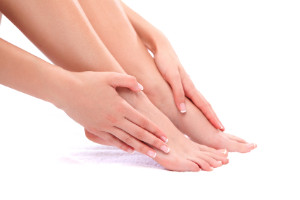
Connellsville

 One of the functions of the cuboid bones is to maintain stability and mobility while walking. The pain that can result from a cuboid bone injury is generally felt on the outside of the foot, and causes difficulty walking and running. Cuboid syndrome can happen suddenly, and patients may develop this condition from incurring an ankle sprain. Additionally, it may occur from frequently wearing high heels or in athletes who participate in jumping activities. Mild relief may be found when weight is taken off of the affected foot, which can make it easier to move the foot. After a proper diagnosis is given, there may be specific stretches that can be practiced which can promote healing. If you have pain in this part of your foot, it is suggested that you confer with a podiatrist who can effectively treat this condition.
One of the functions of the cuboid bones is to maintain stability and mobility while walking. The pain that can result from a cuboid bone injury is generally felt on the outside of the foot, and causes difficulty walking and running. Cuboid syndrome can happen suddenly, and patients may develop this condition from incurring an ankle sprain. Additionally, it may occur from frequently wearing high heels or in athletes who participate in jumping activities. Mild relief may be found when weight is taken off of the affected foot, which can make it easier to move the foot. After a proper diagnosis is given, there may be specific stretches that can be practiced which can promote healing. If you have pain in this part of your foot, it is suggested that you confer with a podiatrist who can effectively treat this condition.
Cuboid syndrome, also known as cuboid subluxation, occurs when the joints and ligaments near the cuboid bone in the foot become torn. If you have cuboid syndrome, consult with Dr. Arnold Tarpley, Jr. from Tarpley Foot and Ankle Center. Dr. Tarpley will assess your condition and provide you with quality foot and ankle treatment.
Cuboid syndrome is a common cause of lateral foot pain, which is pain on the outside of the foot. The condition may happen suddenly due to an ankle sprain, or it may develop slowly overtime from repetitive tension through the bone and surrounding structures.
Causes
The most common causes of cuboid syndrome include:
Symptoms
A common symptom of cuboid syndrome is pain along the outside of the foot which can be felt in the ankle and toes. This pain may create walking difficulties and may cause those with the condition to walk with a limp.
Diagnosis
Diagnosis of cuboid syndrome is often difficult, and it is often misdiagnosed. X-rays, MRIs and CT scans often fail to properly show the cuboid subluxation. Although there isn’t a specific test used to diagnose cuboid syndrome, your podiatrist will usually check if pain is felt while pressing firmly on the cuboid bone of your foot.
Treatment
Just as the range of causes varies widely, so do treatments. Some more common treatments are ice therapy, rest, exercise, taping, and orthotics.
If you have any questions, please feel free to contact one of our offices located in Uniontown, and Connellsville, PA . We offer the newest diagnostic and treatment technologies for all your foot care needs.